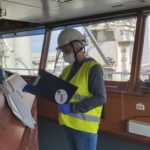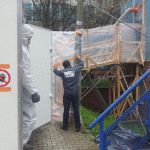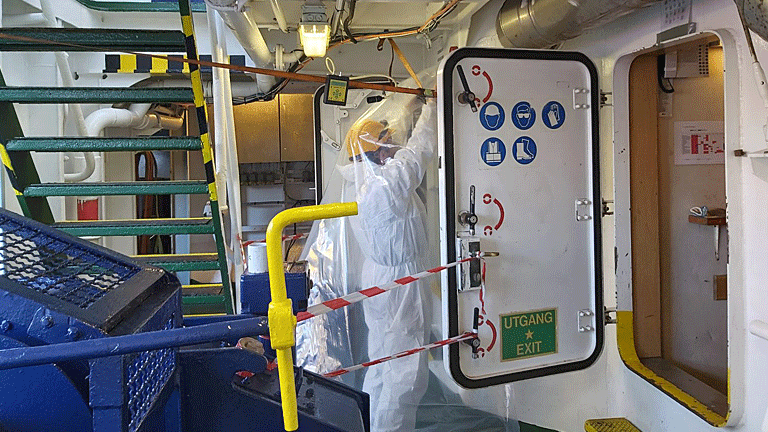Disposal ACM (Asbestos Containing Materials), Does asbestos prohibited for all ships without exception? Removal or no?
Asbestos is found onboard. There has been an increased focus on the potential existence of asbestos on board new and existing ships. The Dutch Shipping Department of the Human Environment and Transport Inspectorate. (ILT/Scheepvaart) will be carrying out on-board checks for asbestos in the 3rd/4th quarter of 2012. Since the 1st of July 2002 the new installation or use of asbestos-containing materials (ACMs). On board sea-going vessels has been prohibited under SOLAS regulations II-1/3-5. From 1 January 2011, new installation of ACMs (Asbestos Containing Materials) is prohibited without exception for all sea-going vessels.
Asbestos is used for its specific characteristics such as fire resistance, thermal insulation, electrical insulation, strength, flexibility, etc. Therefore, asbestos is used in various locations throughout a ship. It is a fibrous material and can often be identified visually on that basis. However, most asbestos is used on board in materials where it cannot easily be identified visually. Indicatively, asbestos can be found within the components of the following shipboard equipment:
- Propeller shafting (Packing with casing,Clutch,Brake lining)
- Diesel engine (Packing with piping flange,Lagging material for fuel pipe,Lagging material turbocharger)
- Boiler (Insulation in combustion chamber,Gasket for manhole,Gas shield packing for soot blower and other hole,Gasket for hand hole)
- Incinerator (Packing for casing door,Packing with hand hole)
- Air-conditioning system (Sheet packing, lagging material for piping and flexiblejoint)
For new installations and new buildings with a keel laid on or after 1 January 2011, new installation of materials which contain asbestos shall be prohibited. The phrase “new installation of materials containing asbestos” means any new physical installation on board. Any material purchased prior to 1 January 2011 years. Being kept in the ship’s store or in the shipyard for a ship under construction. It should not be permitted to be installed after 1 January 2011 as a working part.
Verification, confirmation – IHM (Inventory of Hazardous Material)
Verification that there are no “new installation of materials which contain asbestos” onboard a ship is to be made by Recognized Organizations by reviewing asbestos-freedeclarations and supporting documentation. For the structure, machinery, electricalinstallations and equipment covered by the SOLAS Convention. Fornew constructions or conversions made after 01 July 2012 such documentation should be provided to the ROs by theshipyards, repair yards, and equipment manufacturers.
If asbestos is detected on board onboard a vessel, actions should be taken to have it removed. In case any crew member who is, or is believed to be, working regularly in the vicinity of asbestos to which he might in consequence be exposed should report to the Master immediately. For any defects (such as cracks or flaking)or any deterioration in the condition of the asbestos. All crew members should be informed and access to the site must be restricted to as few crew members as possible. The disposal ACM should be assigned to professional asbestos removal companies and should take place within a time frame of 3 years from the date when the contravention is found.
When asbestos is detected on board.
When asbestos is detected on board a certificate of exemption should be issued from the flag State. For no more than three years in order to give the company the time to arrange for the disposal of asbestos material from the vessel. In order to submit a proper application to the flag state for exemption certificate, the company should:
- Assign a professional asbestos removal company to prepare a plan for the removal of the asbestos
- Develop, along with the external contractor responsible for the asbestos removal. An action plan which specifically states the items/components that should be removed
- Specify the location and time of the removal
- Include the asbestos removal plan in the application
For ships built before the 1st of July 2002, asbestos is still allowed in the existing construction. It is the responsibility of the ship owner to warrant that no ACMs are damaged. That they will not create a hazardous environment for the crew and persons visiting the ship. The crew should be aware of the dangers of asbestos and should know. How to deal with asbestos in case disturbance of the ACMs cannot be avoided. In this case the development of an Asbestos Management Plan incorporated within the company’s SMS should provide an adequate solution in order to set up procedures on how to manage and control asbestos on board. An asbestos management plan should include:
- the identification of asbestos and ACM. For example a reference or link to an asbestos register (a register containing the locations, equipment, quantities of asbestos onboard)
- safe working procedures and control measures while disposal ACM
- procedures for detailing accidents, incidents or emergencies of asbestos
- training responsibilities
- an outline of how asbestos risks will be controlled, including consideration of appropriate control measures
- a timetable for managing risks of exposure. For example priorities and dates for any reviews, circumstances and activities that could affect the timing of action
- identification of each person with responsibilities under the asbestos management plan and the person’s responsibilities
- procedures, including a timetable for reviewing and, if necessary, revising the asbestos management plan and asbestos register
For further reading regarding asbestos in the shipping industry from a regulatory point of view please refer to the following documentation
- MSC.1/Circ.1379 – Unified interpretation of SOLAS regulation II-1/3-5
- MSC.1/Circ.1374 – Information on prohibiting the use of asbestos on board ships
- MEPC.197(62), Appendix 5, paragraph 2.2.2.1. -2011 Guidelines for the development of the inventory of hazardous materials
- MSC.1/Circ.1045 – Guidelines for maintenance and monitoring of on-board materials containing asbestos
- Directive 2009/148/EC – Protection of workers from the risks related to exposure to asbestos at work






